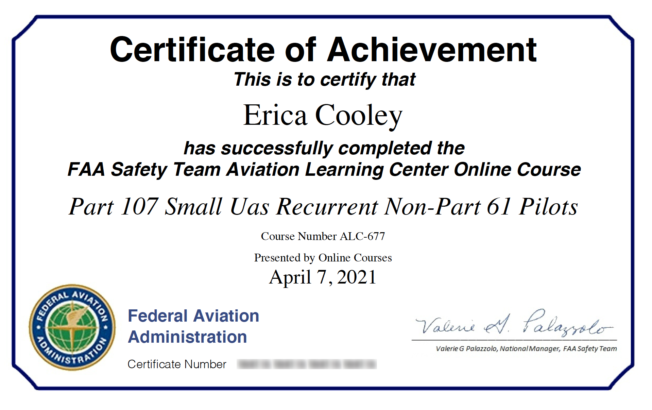Your guide to taking the FAA’s updated Part 107 sUAS recurrent online training course and exam.
Watch this video for guidance on the FAA’s updated Part 107 sUAS recurrent online training course and exam.
On April 6th, the FAA released the revised Unmanned Aircraft General (UAG) airman knowledge test to include revisions of 14 CFR part 107 and a new 14 CFR part 89 information on operations over people, remote identification, and night operations. Also effective as of April 6th, the Unmanned Aircraft Recurrent (UGR) airman knowledge test is no longer offered for the knowledge recency requirement. Any person who holds a Remote Pilot Certificate with a Small Aircraft Rating may take the free, online recurrent training in place of the UGR airman knowledge test. Keep reading for guidance on taking the new Part 107 recurrent training course and exam.
Guidance for taking the ALC-677: Part 107 Small UAS Recurrent Training Course and Exam
- Login at https://faasafety.gov/ and enroll in the ‘ALC-677: Part 107 Small UAS Recurrent’ course.
- From the Course Overview click the number ‘1’ in the top bar in yellow. Then click the blue play button to open the training course window.
- Important information from the Characteristics and Requirements for sUAS lesson:
-
- Characteristics of an sUAS
- Part 107 exclusions
- Registration marking requirements stating the unique identifier number issued by the FAA for your UAS must be legibly, durably labeled in a visible location on the external surface of your aircraft
For the Knowledge Check for this lesson make sure you understand the difference between commercial and recreational UAS operations and which type of operations are subject to part 107 regulations.
- Important information from the ‘Remote Pilot in Command Responsibilities’ lesson:
-
- The role of the Remote Pilot in command
- Other supporting crew roles
- Best practices for crew resource management
The Knowledge Check for this lesson requires you to understand the different sUAS crewmember roles.
- Important information from the ‘Preflight Conditions’ lesson:
-
- Recommended drone maintenance requirements including an understanding of how to perform scheduled and unscheduled maintenance.
- Preflight inspection requirements
- Compliance with Part 89 Remote Identification requirements
The Knowledge Check for this lesson includes manufacturer maintenance guidance and required conduct for preflight inspections. Important preflight inspection requirements outlined in this lesson are the effect different weather conditions and operating environments like tall buildings can have on the performance of a UAS. Lastly, under the new CFR 14 part 89, remote identification will be required for all commercial UAS. While commercial and recreational UAS drone pilots won’t be required to comply with the remote identification rules till September 16th, 2023, understanding the operating rules for compliance under part 107 is essential to pass this course and maintain FAA-compliant operations in the near future.
- Important information from the ‘Operating Rules’ lesson:
-
- Operational requirements and limitations for sUAS
- Certificates of waiver for select requirements in part 107
- Civil twilight and night operations requirements including an explanation of civil twilight/sunset, anti-collision light requirements, and challenges of flying at night (night illusions and physiology)
- Regulations for operations over people including the different categories’ requirements and restrictions
- Requirements for operations from a moving vehicle or aircraft
- Impairment and UAS operations
To note as of March 16th, 2021, with the successful completion of this online course all Part 107 pilots will be able to perform (following the parameters explained in this module) twilight/night operations in uncontrolled airspace without a waiver.
The Knowledge Check for this lesson includes defining types of night illusions, assessment of the compliance of different operational scenarios, and requirements for the categories of operations over people.
- Important information from the ‘Abnormal and Emergency Situations’ lesson:
-
- Emergency planning and communication
- Examples of common abnormal situations like lost link, alternate landing/recovery sites, and flight termination and what to do in occurrence
- Examples of common emergency situations like flyaways, loss of GPS and battery fires, and what to do in occurrence
- Accident reporting to the FAA requirements
The Knowledge Check for this lesson includes assessments of required actions for different abnormal and emergency scenarios and accident reporting requirements.
- You have now completed all the training modules for this course, the last step is to take the end-of-training knowledge test to receive credit.
-
- Exit the training window and then click ‘Exam’ to complete the end-of-training knowledge check. This test is a compilation of the key information from each lesson and each module’s knowledge check. If you missed any questions in the knowledge checks, I recommend going back and reviewing those questions and answers prior to taking the exam.
- Upon completion, print your training completion certificate and retain it as proof of recency along with your original Part 107 license. Below is an example of what the certificate looks like.

If you hold a part 61 pilot certificate and have a current part 61.56 flight review, complete the Part 107 Small Unmanned Aircraft Systems (small UAS) Recurrent online training course here.
The updated Part 107 sUAS recurrent online training course and exam provides essential information on the regulatory changes to operations over people and at night as well as the future implementation of remote ID requirements. This free, online, educational course ensures that every Part 107 pilot operating in the NAS is educated on how to conduct UAS operations safely and compliantly now and in the future. We wish you luck in your recurrent training course and exam. Feel free to contact our team with any questions at support@aloft.ai.
Erica Cooley
Erica Cooley is Aloft’s Head of Community, she’s responsible for connecting with the expanding drone community to provide educational opportunities on how to leverage technology to fly with compliance and safety. Erica is an FAA-certified Part 107 Remote Pilot since 2017. Her passion for gender and diversity inclusion in the UAS industry is demonstrated as a proud member of Women and Drones & a brand ambassador for Women Who Drone. She is also an FAA Safety Team Representative in the Seattle, WA area. Erica received her BA from the University of Puget Sound in Communication Studies.



